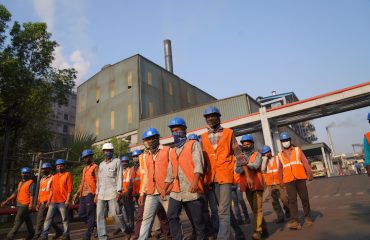High-strength, low-alloy (HSLA) steel HEA profiles are increasingly popular in the construction of heavy load structures due to their exceptional strength-to-weight ratio and superior performance characteristics. This comprehensive guide delves into the intricacies of utilizing HEA profiles, covering crucial aspects from selection to analysis, ensuring optimal design for your heavy-duty projects.
Understanding HEA Profile Properties and Applications
HEA profiles, designated by the “HEA” prefix followed by a numerical value representing the nominal depth in millimeters (e.g., HEA 200, HEA 300), are hot-rolled I-sections characterized by their high yield strength and relatively slender web. This combination makes them ideal for applications requiring high load-bearing capacity while minimizing structural weight. Common applications include:
- Bridges and Viaducts: Their high strength allows for longer spans and reduced material usage.
- High-Rise Buildings: HEA profiles contribute to the structural integrity of skyscrapers, particularly in columns and beams.
- Industrial Structures: They are well-suited for heavy industrial applications like warehouses, factories, and power plants.
- Offshore Platforms: The strength and corrosion resistance (with appropriate surface treatments) make them suitable for demanding marine environments.
- Crane Structures: Their ability to withstand significant dynamic loads is crucial in crane design.
Understanding the specific material properties of the chosen HEA profile, including yield strength, ultimate tensile strength, and elastic modulus, is paramount for accurate design calculations.
Selecting the Appropriate HEA Profile for Your Project
Selecting the right HEA profile involves careful consideration of various factors. The primary factor is the anticipated load, encompassing both static (dead load, permanent loads) and dynamic (live load, wind load, seismic load) components. Detailed load calculations are essential, often requiring the expertise of structural engineers. Other crucial factors include:
- Span Length: Longer spans necessitate deeper and stronger sections.
- Support Conditions: Simply supported beams have different design requirements compared to cantilever or continuous beams.
- Deflection Limits: Excessive deflection can compromise the functionality and aesthetics of a structure. Codes and standards specify allowable deflection limits.
- Stability Requirements: Slender HEA profiles can be susceptible to buckling under compressive loads. Lateral-torsional buckling needs careful consideration, often requiring bracing or stiffeners.
- Fabrication and Construction Constraints: Practical considerations such as accessibility, welding capabilities, and transportation limitations should be incorporated into the selection process.
Using appropriate design software and adhering to relevant building codes and standards is crucial for ensuring the structural integrity and safety of the project.
Detailed Design Considerations for HEA Profiles
The design process extends beyond simply selecting the appropriate HEA profile. Several critical aspects require meticulous attention:
- Connection Design: The strength of the entire structure depends heavily on the integrity of the connections between HEA profiles and other structural elements. Proper detailing of welds, bolts, and other fasteners is crucial.
- Local Buckling: Concentrated loads or abrupt changes in geometry can induce local buckling in the web or flanges of the HEA profile. Reinforcement or design modifications might be necessary to mitigate this risk.
- Shear Capacity: HEA profiles must be checked for shear capacity, especially in regions near supports or concentrated loads. Web stiffeners may be required to enhance shear resistance.
- Fatigue Analysis: For structures subjected to repeated cyclic loading, fatigue analysis is essential to ensure that the HEA profiles can withstand the accumulated stress cycles without failure.
- Corrosion Protection: Appropriate surface treatments, such as painting or galvanizing, are crucial to protect HEA profiles from corrosion, especially in harsh environments.
Employing advanced Finite Element Analysis (FEA) techniques can significantly enhance the accuracy and reliability of the design process.
Advanced Analysis Techniques for Heavy Load Structures using HEA Profiles
Advanced analysis techniques are often required to accurately predict the behavior of heavy load structures utilizing HEA profiles. These techniques go beyond simple hand calculations and leverage the power of computational tools:
- Finite Element Analysis (FEA): FEA allows for a detailed simulation of the structural behavior under various loading conditions, providing accurate predictions of stresses, deflections, and buckling behavior.
- Nonlinear Analysis: Nonlinear analysis accounts for material nonlinearity (plasticity) and geometric nonlinearity (large deflections), leading to more realistic predictions, especially under extreme loading conditions.
- Dynamic Analysis: For structures subjected to dynamic loads (e.g., earthquakes, wind gusts), dynamic analysis is essential to determine the response of the structure and ensure its stability.
- Buckling Analysis: Detailed buckling analysis is crucial for slender HEA profiles to determine the critical loads that could lead to instability and failure.
- Seismic Analysis: In seismically active regions, seismic analysis is mandatory to ensure that the structure can withstand earthquake forces without collapse.
Experienced structural engineers proficient in these advanced analysis techniques are indispensable for designing safe and reliable heavy load structures.
Ensuring Code Compliance and Structural Integrity
Adherence to relevant building codes and standards is paramount. These codes provide minimum requirements for structural design and ensure public safety. Examples include Eurocodes (EN standards), American Institute of Steel Construction (AISC) specifications, and other regional standards. Furthermore, regular inspections and maintenance are crucial for ensuring the long-term structural integrity of the structure. Early detection and remediation of any potential problems can prevent costly repairs or catastrophic failures. Proper documentation of the design process, including load calculations, analysis results, and material specifications, is also essential for traceability and accountability.
By carefully considering the factors outlined above, engineers can effectively utilize HEA profiles to create robust and efficient heavy load structures that meet the highest standards of safety and performance.
Tags: HEA Profile, Heavy Load Structures, Structural Steel Design, Steel Beam Design, Engineering Analysis




